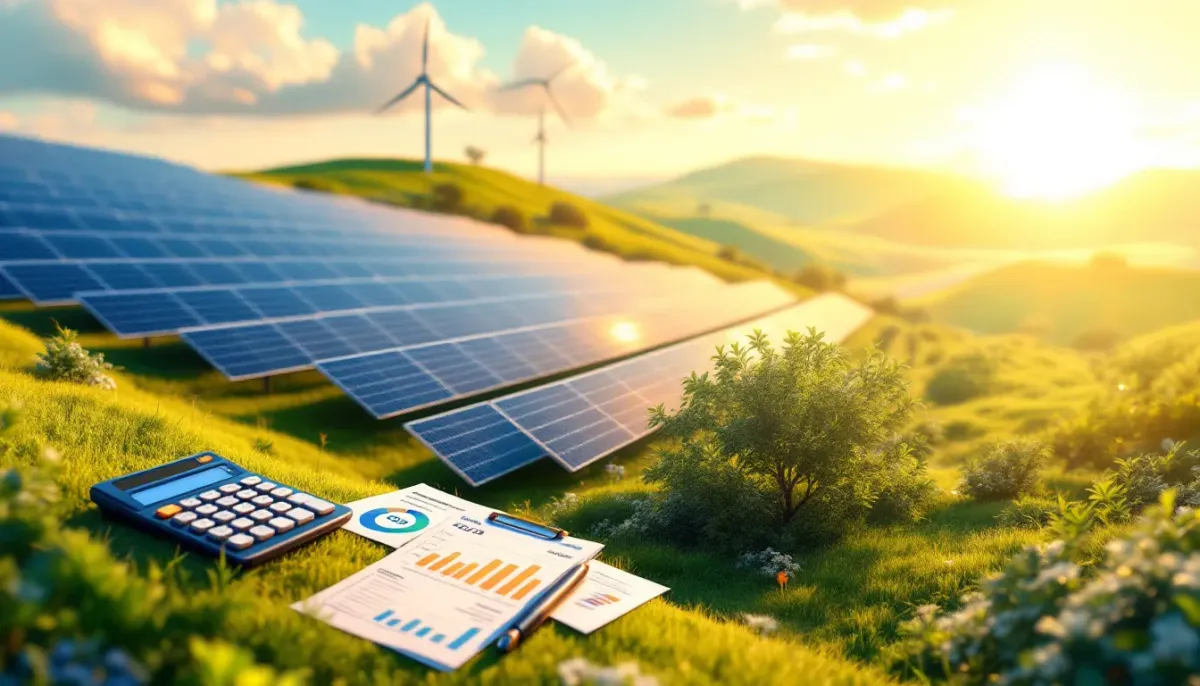Renewable Energy ROI: Calculation Methods
Discover how to calculate ROI for renewable energy investments and understand key metrics like EROI, LCOE, and payback periods.

Want to know if investing in renewable energy is worth it? Here's a quick guide to calculating ROI:
- Add up all costs (equipment, installation, permits)
- Estimate yearly energy production
- Calculate annual energy bill savings
- Include ongoing maintenance costs
- Factor in tax credits and grants
- Use this formula: ROI = (Net Profit / Cost of Investment) x 100
Key things to remember:
- Commercial solar setups can pay for themselves in 5-7 years
- Most solar installations return about 20% ROI in the first year
- Don't forget to consider equipment aging and changing energy prices
| Energy Type | Typical ROI |
|---|---|
| Solar PV | 10% |
| Onshore Wind | 18% |
| Hydropower | 84% |
Calculating ROI helps you plan finances, compare options, and spot risks. But it's not one-size-fits-all. Use online tools for rough estimates, but chat with a pro for the real deal.
Remember: ROI isn't everything. Energy Return on Investment (EROI) matters too. Solar gives about 10 units of energy for every 1 unit put in. Wind? Even better at 18:1.
Bottom line: Do your homework before making big energy moves.
Key Metrics for ROI Calculations
Facilities managers use four main numbers to figure out if renewable energy projects are worth it:
Return on Investment (ROI)
ROI shows your profit compared to your spending. For solar panels in 2023, the average ROI is about 10%. Here's how it works:
1. Calculate net profit: Total savings minus panel cost.
2. Divide by initial cost: This gives you the ROI percentage.
Example: Spend £30,000 on panels, save £33,000 over their lifetime = 10% ROI.
Payback Period
This is how long it takes to earn back what you spent. For UK solar panels, it's usually around 8.7 years. Shorter is better - you start saving sooner.
Levelized Cost of Energy (LCOE)
LCOE helps compare different energy types. It's the total project cost over its lifetime, divided by how much energy it produces.
LCOE = (Total lifetime cost) / (Total lifetime energy produced)
This lets you compare wind and solar power fairly, even if they last different amounts of time.
Energy Return on Investment (EROI)
EROI looks at energy output compared to input:
EROI = Energy Output / Energy Input
Higher is better. The World Nuclear Association says the break-even EROI is 7.
Remember:
- These metrics work together for a full picture.
- Local factors like sunshine and electricity prices affect results.
- Use up-to-date figures for accuracy.
How to Calculate ROI Step-by-Step
Want to know if your renewable energy project is worth it? Let's crunch some numbers.
1. Calculate Initial Costs
First, add up ALL the upfront costs:
- Equipment (solar panels, inverters, etc.)
- Installation labour
- Permits and fees
- Grid connection costs
For a 5 kW solar system, you're looking at £12,000 to £20,000 total.
2. Estimate Yearly Energy Production
Next, figure out how much energy you'll generate each year. This depends on:
- System size and efficiency
- Local weather
- Installation angle and direction
A 5 kW solar array in the UK? About 4,500 kWh per year.
3. Figure Out Annual Energy Savings
Now, turn that energy into cash:
- Find your current electricity rate (say, £0.15 per kWh)
- Multiply by your yearly production
So: 4,500 kWh x £0.15 = £675 saved each year
4. Include Maintenance and Operating Costs
Don't forget the ongoing expenses:
- Cleaning
- Repairs
- Insurance
- Monitoring services
For a home solar system, budget £100-£200 per year.
5. Add in Incentives and Rebates
Look for financial perks:
- Government grants
- Tax credits
- Feed-in tariffs
The UK offers schemes that can cut initial costs or provide extra income.
6. Use the ROI Formula
Here's the magic formula:
ROI = (Total Lifetime Savings - Total Costs) / Total Costs x 100%
Let's run the numbers:
- System cost: £15,000
- Annual savings: £675
- Lifetime (25 years): £16,875
- Maintenance (25 years): £3,750
- ROI = (£16,875 - £18,750) / £18,750 x 100% = -10%
Ouch! A negative ROI. This shows why accurate calculations are CRUCIAL. Don't skip any factors!
What Affects Renewable Energy ROI
The ROI of renewable energy projects hinges on several key factors. Let's break them down:
Technology Performance
Better tech = better ROI. Simple as that.
Solar and wind tech has come a long way:
- Solar panel costs: Down 83% since 2010
- Wind turbine costs: Dropped 85% in the same time
So, newer projects often outperform older ones.
Setup and Equipment Costs
Upfront costs are a big deal. For example:
- Home solar (5 kW): £12,000 to £20,000
- Commercial projects: Millions
Pro tip: Look into UK grants and schemes. They can slash your initial costs.
Energy Prices and Inflation
Market shifts can make or break your ROI:
- Rising grid prices? Solar savings go up.
- Falling prices? Longer payback times.
And don't forget inflation. It can change the value of future savings.
Government Rules and Incentives
Policy changes can flip the script on ROI:
- US Inflation Reduction Act: Sparked a renewable boom
- UK feed-in tariff changes: Shook up solar ROI
Bottom line: Always factor in current and potential policies.
Location and Weather
Where you are matters. A lot.
| Factor | ROI Impact |
|---|---|
| Sunlight | More sun = more solar output |
| Wind | Steady winds = efficient turbines |
| Local electricity rates | Higher rates = faster payback |
Example: A solar panel in Spain will likely outshine one in Scotland.
Remember: ROI isn't just numbers. External factors can shift your returns big time. Keep these elements in mind when planning your renewable energy investments.
Common ROI Calculation Mistakes
When figuring out ROI for renewable energy projects, it's easy to mess up. Here are the big mistakes to avoid:
Missing Hidden Costs
People often forget about sneaky expenses. This makes ROI look better than it really is. Watch out for:
- Installation fees
- Ongoing maintenance
- Insurance premiums
- Grid connection charges
- Potential system upgrades
Include these, and you'll get a clearer picture of your investment's real value.
Wrong Energy Production Estimates
Overestimating energy output? Big mistake. Remember Pepsi's 2010 Refresh Project? It got 3.5 million Facebook likes but didn't boost sales. Lesson learned: measure what matters.
To get it right:
- Use conservative estimates
- Look at historical data
- Think about seasonal changes
- Factor in equipment getting less efficient over time
Forgetting About Equipment Aging
Solar panels and wind turbines don't stay shiny and new forever. They slow down over time, which hits your ROI.
Keep in mind:
- Solar panels usually lose 0.5% to 1% efficiency each year
- Wind turbines can drop 1.6% in output yearly
- Don't forget about replacing inverters and other bits
Misunderstanding Financial Terms
Getting financial concepts mixed up can lead to bad choices. Here's a quick cheat sheet:
| Term | What It Means |
|---|---|
| Net Present Value (NPV) | What future money is worth today |
| Internal Rate of Return (IRR) | Yearly growth rate you can expect |
| Payback Period | How long it takes to get your money back |
Know these terms, make smarter investments. Simple as that.
ROI Calculation Tools
Calculating ROI for renewable energy projects? You need the right tools. Here's a rundown of some useful calculators:
Types of ROI Calculators
| Tool | Function | Ideal Users |
|---|---|---|
| PVWatts Calculator | Estimates energy production and cost for grid-connected PV systems | Homeowners, small building owners, installers |
| PVCalc | Calculates ROI for PV solar projects as financial investments | Investors, project managers |
| PVGIS Estimation Utility | Provides power output estimates based on location | System designers, planners |
| SMA Sunny Design | Generates detailed reports for SMA inverter systems | SMA equipment users |
| Fronius Solar-creator | Configures solar PV systems with Fronius inverters | Fronius equipment users |
Tool Capabilities and Limitations
These calculators are useful, but they're not magic:
They can estimate energy production, calculate basic financial returns, and compare different system setups.
They can't account for all local factors, predict future energy prices, or replace professional advice.
For instance, PVWatts might tell you a 6.9 kW system costs £18,124.70 with pro installation and pays back in 9.44 years. But it won't know about local planning rules or specific equipment performance.
Choosing Your Calculator
Pick the right tool by:
1. Matching it to your equipment (e.g., SolarEdge Designer for SolarEdge inverters)
2. Checking data sources (PVGIS uses historical solar data, good for long-term planning)
3. Looking at outputs (PVCalc shows results in graphs, which can be easier to grasp)
4. Considering your needs (Are you a homeowner or a large-scale investor?)
Conclusion
Calculating ROI for renewable energy projects isn't rocket science. But it's not child's play either. Here's what you need to do:
- Add up ALL your costs. Equipment, installation, permits - the works.
- Figure out how much energy you'll produce each year.
- Calculate your yearly energy bill savings.
- Don't forget ongoing costs like maintenance.
- Factor in any sweet tax credits or grants.
- Use this formula: (Net Profit / Cost of Investment) x 100. That's your ROI percentage.
Why bother with all this number crunching? Simple:
- It helps you plan your finances. A good commercial solar setup can pay for itself in 5-7 years.
- You can compare different green energy options. The Levelized Cost of Energy (LCOE) is great for this.
- You'll spot potential risks, like aging equipment or changing energy prices.
- You won't miss out on valuable incentives. The Federal Solar Tax Credit? That's a 26% tax credit on installation costs.
"Most solar panel installations will return a 20% ROI in the first year", according to industry data.
Here's the deal: ROI calculations aren't one-size-fits-all. Use tools like PVWatts or PVCalc for tailored estimates. But remember, these calculators are helpful, not magical. For the real deal, talk to a pro.
FAQs
How do you calculate energy ROI?
Here's a simple way to figure out your energy ROI:
(Energy savings - Investment) / Investment x 100
Let's say you spend £10,000 on new equipment and save £12,500. Your ROI would be:
(£12,500 - £10,000) / £10,000 x 100 = 25%
You've made back your money plus an extra 25%. Not bad!
Don't forget to:
- Count ALL costs (equipment, setup, permits)
- Add up yearly savings
- Think about upkeep costs
- Look into tax breaks or grants
For renewable energy, here's what you might expect:
| Energy Type | Typical ROI |
|---|---|
| Solar PV | 10% |
| Onshore Wind | 18% |
| Hydropower | 84% |
Tip: Use online tools for rough estimates, but talk to a pro for the real deal.
ROI isn't everything, though. Energy Return on Investment (EROI) matters too. Solar systems give about 10 units of energy for every 1 unit put in. Wind? Even better at 18:1.
Schalk Cloete from Stiftelsen for Industriell og Teknisk Forskning says:
"The true EROI of a technology is just too complex to quantify accurately, given the challenges with assessing full lifecycle energy inputs."
So, while ROI helps, it's not the whole story. Do your homework and chat with experts before making big energy moves.
